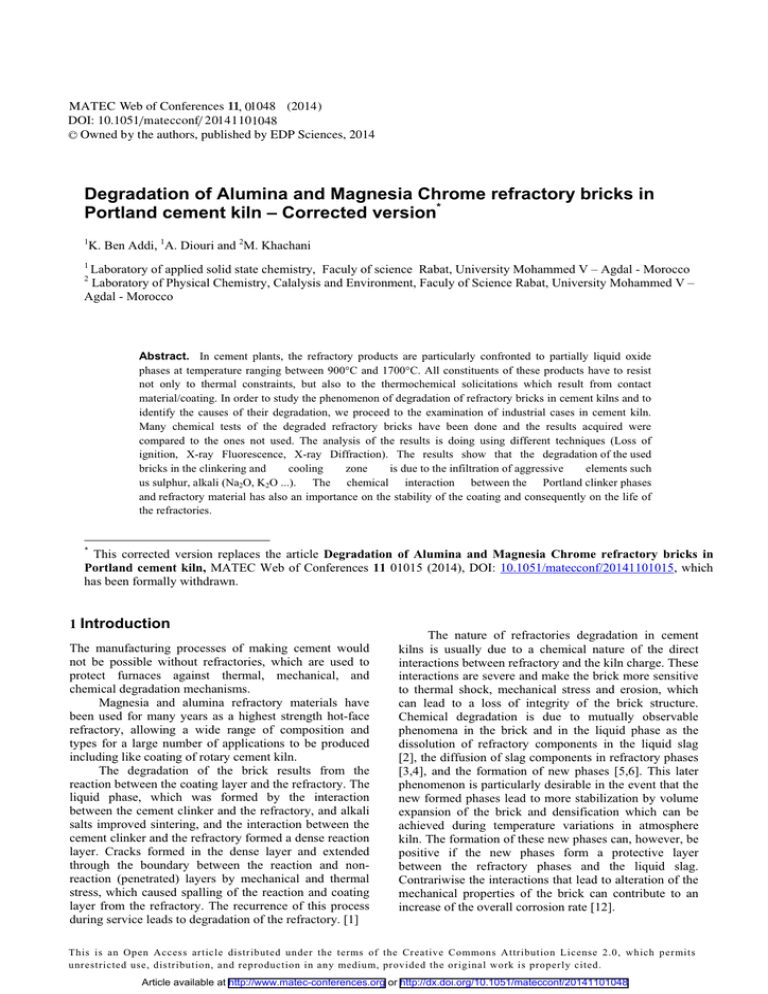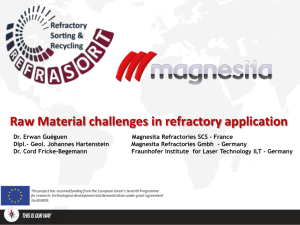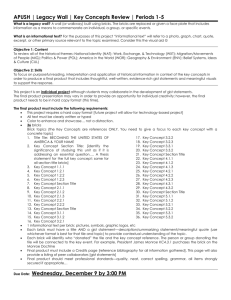Degradation of Alumina and Magnesia Chrome refractory bricks in
advertisement

MATEC Web of Conferences 11, 01048 (2014) DOI: 10.1051/matecconf/ 20141101048 C Owned by the authors, published by EDP Sciences, 2014 Degradation of Alumina and Magnesia Chrome refractory bricks in Portland cement kiln – Corrected version* 1 K. Ben Addi, 1A. Diouri and 2M. Khachani 1 Laboratory of applied solid state chemistry, Faculy of science Rabat, University Mohammed V – Agdal - Morocco Laboratory of Physical Chemistry, Calalysis and Environment, Faculy of Science Rabat, University Mohammed V – Agdal - Morocco 2 Abstract. In cement plants, the refractory products are particularly confronted to partially liquid oxide phases at temperature ranging between 900°C and 1700°C. All constituents of these products have to resist not only to thermal constraints, but also to the thermochemical solicitations which result from contact material/coating. In order to study the phenomenon of degradation of refractory bricks in cement kilns and to identify the causes of their degradation, we proceed to the examination of industrial cases in cement kiln. Many chemical tests of the degraded refractory bricks have been done and the results acquired were compared to the ones not used. The analysis of the results is doing using different techniques (Loss of ignition, X-ray Fluorescence, X-ray Diffraction). The results show that the degradation of the used bricks in the clinkering and cooling zone is due to the infiltration of aggressive elements such us sulphur, alkali (Na2O, K2O ...). The chemical interaction between the Portland clinker phases and refractory material has also an importance on the stability of the coating and consequently on the life of the refractories. * This corrected version replaces the article Degradation of Alumina and Magnesia Chrome refractory bricks in Portland cement kiln, MATEC Web of Conferences 11 01015 (2014), DOI: 10.1051/matecconf/20141101015, which has been formally withdrawn. 1 Introduction The manufacturing processes of making cement would not be possible without refractories, which are used to protect furnaces against thermal, mechanical, and chemical degradation mechanisms. Magnesia and alumina refractory materials have been used for many years as a highest strength hot-face refractory, allowing a wide range of composition and types for a large number of applications to be produced including like coating of rotary cement kiln. The degradation of the brick results from the reaction between the coating layer and the refractory. The liquid phase, which was formed by the interaction between the cement clinker and the refractory, and alkali salts improved sintering, and the interaction between the cement clinker and the refractory formed a dense reaction layer. Cracks formed in the dense layer and extended through the boundary between the reaction and nonreaction (penetrated) layers by mechanical and thermal stress, which caused spalling of the reaction and coating layer from the refractory. The recurrence of this process during service leads to degradation of the refractory. [1] The nature of refractories degradation in cement kilns is usually due to a chemical nature of the direct interactions between refractory and the kiln charge. These interactions are severe and make the brick more sensitive to thermal shock, mechanical stress and erosion, which can lead to a loss of integrity of the brick structure. Chemical degradation is due to mutually observable phenomena in the brick and in the liquid phase as the dissolution of refractory components in the liquid slag [2], the diffusion of slag components in refractory phases [3,4], and the formation of new phases [5,6]. This later phenomenon is particularly desirable in the event that the new formed phases lead to more stabilization by volume expansion of the brick and densification which can be achieved during temperature variations in atmosphere kiln. The formation of these new phases can, however, be positive if the new phases form a protective layer between the refractory phases and the liquid slag. Contrariwise the interactions that lead to alteration of the mechanical properties of the brick can contribute to an increase of the overall corrosion rate [12]. This is an Open Access article distributed under the terms of the Creative Commons Attribution License 2.0, which permits unrestricted use, distribution, and reproduction in any medium, provided the original work is properly cited. Article available at http://www.matec-conferences.org or http://dx.doi.org/10.1051/matecconf/20141101048 MATEC Web of Conferences Furthemore, Diouri and al. [7], showed that the infiltration of cement phases, especially -Ca2SiO4 in magnesia spinel refractory is responsable of destruction of spinel MgAl2O4 in the hot side of bricks. Qotaibi and all. [8], indicate that the destruction of magnesia chrome bricks in the clinkering zone lining of rotary cement kilns was characterized by 1) The disappearance of Mg2SiO4, and spinel Mg(Al1,5SCr0,5)O4 in the intrados face. 2) The penetration of clinker phases Ca3SiO5, Ca2SiO4, and Ca3Al2O6 through the hot side of the refractory, More recent study of Recio Dominguez and all. [9] has revealed that the attack take place due to the action of the potassium, sulphur, lime and chlorine. These mainly react with the refractory castable matrix giving rise to the penetration of this elements .On the other hand, most of these elements, give rise to a volume expansion, which increases the permeability of the refractory brick and their weakness. In this paper we study the degradation of alumina and magnesia chrome refractory bricks in Portland cement kiln. The analysis of the results is doing using different techniques, Loss of ignition, X-ray Fluorescence and Xray Diffraction. Macroscopic aspects of degraded bricks Figures 1 and 2 show the macroscopic aspect of degraded bricks, we observed the formation of two superimposed layers at the sides in contact with the flow of material inside the furnace: • Intrados: Located at the internal side of coating; it is composed from a grey color matter. • Extrados: The external part of the coating. Figure 1. Macroscopic aspect of refractory brick aluminasilica-type (R 2000). 2 Experimental Procedures and Results To make the analysis, the sample was taken from new refractory bricks before degradation. The types of bricks used in Moroccan cement kiln are: • Magnesia-chrome used in clinkering and transition zone. • Aluminous silica used in the cooling zone. 2.1 Specifications and macroscopic aspects of refractory Specifications: Table 1 gathers specifications of investigated bricks given by the manufacturer. Table 1. Physical data of refractories bricks Refractories bricks unused Chemical composition (%) 3 Mass density (g/cm ) Porosity (%) Pyrometric cone equivalent (ºC) Average linear expansion R 2000 N MgO Si2O3 80 - 85 60 - 70 2,85 - 3,00 2,10 16 - 18 25 > 1700 > 1700 400 °C 0,40 800 °C 0,80 1200 °C 1,40 Thermal 300 °C 700 °C conductibility 1000 °C (Kcal/h.m.°C) Thermal shock resistance (Mpa) Compressive strength cold (MPa) Modulus of elasticity (MPa) ALMAG N 0,60 Figure 2. Macroscopic aspect of refractory brick Magnesia chrome (ALMAG). 2.2 Analysis and results The samples are crushed by a jaw crusher then ground by a disc mill and analysed by X-ray fluorescence and diffraction. Loss on ignition is determined by ignited samples at 990 ° C for half an hour. 2.2.1 Loss on ignition Loss on ignition is widely used as a quick and cheapest method to determinate the carbonate content in the original sample. In order to find the amount of carbon dioxide evolved from the breakdown of the carbonate CaO + CO2), we put 2g of the sample (CaCO3 in a platinum crucible then we ignited at 990 ° C for half an hour. The results are reported in table 2. 4,00 3,00 2,00 Table 2. loss on ignition of the intrados and extrados of new and degraded bricks. 2,70 > 100 > 100 65 110 °C 16 500 °C 16 1000 °C 18 1500 °C 16 R2000 N Loss on ignition % 01048-p.2 0.38872 DR2000 DR2000 ALMAG DALMAG DALMAG EX IN N EX IN 0.48021 5.54896 0.31443 0.43484 3.42038 CMSS 2013 2.2.1 X-ray fluorescence X-ray Fluorescence (XRF) is a widely used technique for both qualitative and quantitative elemental analysis of solids, powders. The pearls were prepared by adding 5g of lithium titraborate (melted) to 1g of crushed and grounded bricks, the homogenized mixture was placed into a Platinum crucible and brought up to the complete melting until pearl level; the melt is poured into the mold and cooled up until the pearl detached from the mold. The results of complete analysis of tow refractory brick types, alumina-silica (R2000) and magnesia chrome (ALMAG) are summarised in Tables 3 and 4. The DR2000 IN and DR2000 EX of the used R2000 samples (figure 3, table 5) are compared to the new ones and show the presence of: - Andalusite Al2(SiO4). - Mullite Al4,4Si1,5 O9. - Almandine Fe3(Al2Si3O12). - Sillimandine Al2SiO5. Table 3. Comparison between bricks R2000 N and DR2000 (Intrados: IN, Extrados: EX). SiO2 % Al2O3 % Fe2O3 % CaO % MgO % SO3 % K2O % TiO2 % MnO % P2O5 % Na2O % R2000N 51,40 40,09 0,32 1,56 5,07 0,02 0,33 1,13 0,00 0,02 0,04 DR2000EX 51,47 40,23 0,37 1,40 5,01 0,02 0,33 1,09 0,01 0,02 0,05 DR2000IN 53,41 43,39 0,62 1,72 0,10 0,01 0,43 0,01 0,00 0,12 0,09 Table 4. Comparison between bricks ALMAG N and DALMAG (Intrados: IN, Extrados: EX). SiO2 % Al2O3 % Fe2O3 % CaO % MgO % SO3 % K2O % TiO2 % MnO % P2O5 % Na2O % SrO % ZnO % ALMAGN 6,31 16,07 4,01 1,43 70,57 0,01 0,13 0,72 0,05 0,10 0,25 0,02 0,00 DALMAGEX 6,78 16,23 4,18 1,50 69,60 0,10 0,45 0,70 0,04 0,11 0,27 0,02 0,00 DALMAGIN 10,90 20,23 4,50 5,56 50,12 2,11 2,16 0,40 0,03 2,20 2,57 0,01 0,01 Figure 3. X-ray diffraction spectra of the refractory brick R2000 before and after degradation (IN, EX). 2.2.1 X-ray diffraction XRD analyses are performed in order to examine the mineralogical composition of the samples. The diagrams were collected using a Siemens D 500 Powder diffractometer equipped with a copper anticathode (OCuKD=1.5418 Å) at scanning speed of 0.04°.s-1 from 10 to 60°/2. Different phases are identified for both samples R2000 and ALMAG and their percentages are respectively presented in figures and tables below. Table 5. Percentages of identified phases in R2000 samples R2000N DR2000EX DR2000IN Andalusite Al2(SiO4) 43,47% 45,03% 19,94% Mullite Al4,4Si1,5O9 19,05% 18,83% 11,44% Almandine 23,50% 22,52% 17,28% Fe3(Al2Si3O12) Sillimandine Al2SiO5 13,97% 13,60% 15,29% Wollastonite CaSiO3 11,92% Calcuim Aluminuim 7,38% Silicate Ca1,8Al3,6SiO8 Silicate bicalcique 9,96% Ca2SiO4 Silicate tricalcique 6,77% Ca3SiO5 The DALMAGIN and DALMAGEX of the used ALMAG brick samples (figure 4, table 6) are compared to the new ones and show the presence of: - Magnesia MgO. - Spinel Mg (Al1,86Cr0,14)O4. - Magnesium Aluminum Oxide MgAl2O4. - Magnesium chromium Oxide MgCrO4. 01048-p.3 MATEC Web of Conferences 3 Discussions Figure 4. The spectra of X-ray diffraction of the refractory brick ALMAG before and after degradation (IN, EX). Table 6. Percentages of the phases identified in brick ALMAGN Spinel Mg (Al1,86Cr0,14 )O4 Magnesium Alumunuim Oxide MgAl2O4 Magnesie MgO Magnesium Chromium Oxide MgCrO4 Kisrchsteinite CaFe2SiO4 Silicate bicalcique Ca2SiO4 Silicate tricalcique Ca3SiO5 Calcium Chromium Silicon Oxide Ca5Cr2SiO12 ALMAG N DALMAGEX DALMAGIN 30,54% 33,32% 2,94% 21,59% 20,20% 9;08% 21,30% 29,87% 13,43% 26,12% 26,59% 8,86% - - 14,10% - - 17,06% - - 13,78% - - 20,71% We note, in both cases, the presence of silicate phases from clinker Ca2SiO4 and Ca3SiO5 on the intrados faces of samples DR2000IN and DALMAGIN. Moreover in each case there is formed a new phase by interaction between Clinker silicates and refractory materials. The new identified phases are respectively Ca1,8Al3,6SiO8 in the DR2000IN sample and Ca5Cr2SiO12 in DALMAGIN sample The comparison of refractory bricks, new and used ones, shows after analyzes a degradation of Intrados faces. An increase in the loss of ignition on samples DR2000 IN and DALMAG IN is apparently due to the infiltration of silicate phases through the layers of refractories while for D R2000 IN used in the zone of cooling; we observed an increase in percentage of silica and alumina due to the slag phases of the matter infiltrated through the pores of refractory. This result is agrees with previous published results [10, 12]. For the sample DALMAG IN used in the clinkerisation zone, an increase on the percentages of alkaline elements K2O (+2.03), P2O5 (+2.10), SO3 (+2.10), and of Na2O (+2.32) is observed, these alkaline compounds are very aggressive for refractory bricks, they are basic elements from ashes of used coal combustion in the cement kiln. These compounds can contribute to the reduction of the basic element of bricks, the magnesia (%MgO: from 70,57 in ALMAGN to 50,12 in DALMAGIN), and by consequence a reduction in the resistance of bricks, As a remark, this results, deduced here, is the same obtained by [11] The degradation of brick of the aluminous-slice type (R2000) is characterized by the partial destruction of the phases Al4,4Si 1,5O9 and Fe2(Al2Si3O12) and by the appearance of new phases such as CaSiO3 Wollastonite, Calcuim Aluminuim Silicates Ca1,8Al3,6SiO8, dicalcium silicate Ca2SiO4 and tricalcium silicate Ca3SiO5 of clinker which are infiltrated through the pores of the intrados of the brick. The degradation of brick magnesia-Chrome (ALMAG) type is characterized by the partial destruction of the phases, Mg (Al1,86Cr0,14)O4 spinel and MgAl2O4, and the appearance of new phases such as Calcuim Chromuim Silicon Oxide Ca5Cr2SiO12, Kirschsteinite CaFe2SiO4, Silicates bicalsic Ca2SiO4, and Silicates tricalcic Ca3SiO5 of the clinker which are also infiltrated through the intrados of the bricks, this is in agreement with , SCHEUNIS and all.[12] who observed that the reaction between the refractory sample and the in¿ltrating liquid leads to the formation of new phases. This degradation in these two refractory bricks was primarily due to the dissolution of the spinel which involves a reduction in the resistance of refractory. The corrosion of refractory bricks by cement clinkers has been described by several researchers [13– 14]. BrieÀy, it has been reported that the liquid phase in the clinker, which is predominately enriched in calcium, iron and aluminum, rapidly diffuses and preferentially reacts with spinel and magnesia in the bricks. 4 Conclusions The contact of the refractory at high temperature with the mineral phases of clinker produces reactions which lead to high or less strong degradations of the coating. Thus we carried out many degradation tests at the laboratory on refractory bricks and the result obtained are compared with the same not used materials. 01048-p.4 CMSS 2013 The analysis of the results using the various techniques (loss on the ignition, complete analysis by XRF and XRD) shows a degradation of bricks used on the level of the clinkerization and cooling zone. This degradation is due to corrosive elements such as sulfur, alkalis (Na2O, K2O, ...), which cause a decrease in the principal phase of the brick and thus contribute to reducing the resistance of bricks The chemical interaction between the Portland clinker and heat resistant materials is very important to understand because it can lead to a good stability of the layer of crusting and therefore influence on the life of refractory. References [1] GUANGPING L., NAN L., WEN Y., CHANGHE G., WEI ZHOU, YUANYUAN L., Composition and microstructure of a periclase–composite spinel brick used in the burning zone of a cement rotary kiln, Ceramics International, 2013 [2] LEE W.E., ZHANG S., Melt corrosion of oxide and oxide–carbon refractories, IntMater Rev 1999, 44, 77–104. [3] PETKOV V., JONES P.T., BOYDENS E., BLANPAIN B., WOLLANTS P., Chemical corrosion mechanisms of magnesia–chromite and chrome-free refractory bricks by copper metal and anode slag, J Eur Ceram Soc 2007, 27. [4] KAUR R.R., SWINBOURNE D.R., WADSLEY M.W., NEXHIP C., Comparison of ferrous calcium silicate slag and calcium ferrite slag interactions with magnesia–chromeRefractories, Metall Mater Trans B: Proc Metall MaterProc Sci , 2011, 42, 451 – 9. [5] ZHANG S., SARPOOLAKY H., MARRIOTT N.J., LEE W.E. Penetration and corrosion of magnesia grain by silicate slags, Br Ceram Trans, 2000, 99 , 248 –55. [6] POIRIER J., QAFSSAOUI F., ILDEFONSE J.P., BOUCHETOU M.L., Analysis and interpretation of refractory microstructures in studies of corrosion mechanisms by liquid oxides, JeurCeramSoc, 2008, 28. [7] DIOURI A., OUICHOU L., BOUKHARl A., Interaction charge-brique rcfractaire en magnesie spinelle dans un four industriel marocain, J. Chim. phys, 1991, 88, 2341. [8] QOTAIBI Z., DIOURI A., BOUMARI A., TAIBI M., ARIDE J., Analysis of magnesia chrome rjwractories weared In a rotary cement kiln nn. Chim. Sci. Mat, 1998,23, pp. 169-172. [9] RECIO DOMINGUEZ I., GOMEZ-MILLAN J.,ALVAREZ M.,DEAZA S., CONTRERAS L., DE AZA A.H., Build-up formation and corrosion of monolithic refractoriesin cement kiln preheaters, Journal of the European Ceramic Society, 2010, 30 . [10] POIRIER J., QAFSSAOUI F., ILDE FONSE J.P., BOUCHETOU M.L., Analusis and interpretation of refractory microstructures in studies of corrosion mechanisms by liquid oxides, Journal of the European Ceramic Society , 2008. [11] STJERNBERG J., OLIVAS-OGAZ M.A., ANTTI M.L., ION J.C., LINDBLOM B., Laboratory scale study of the degradation of mullite refractories by reaction with alkali-doped deposit materials Ceramics International, 2013, 93, 791–800. [12] SCHEUNIS L., FALLAH MEHRJARDI A., CAMPFORTS M., JONES P.T., BLANPAIN B., JAK E., The effect of phase formation during use on the chemical corrosion of magnesia–chromite refractories in contact with a non-ferrous PbO– SiO2based slag, Journal of the European Ceramic Society, 2014. [13] SERENA S., SAINZ M.A., CABALLERO A., Corrosion behaviour of MgO/ CaZrO refractory matrix by clinker, J. Eur. Ceram. Soc.2004, 24,2399–2406. [14] GALICIA J.L.R.,AZA A.H.D., ANGELES J.C.R., P. PENA, The mechanism of corrosion of MgO– CaZrO –calcium silicate materials by cement clinker, J. Eur. Ceram. Soc, 2007, 27, 79–89. 01048-p.5






